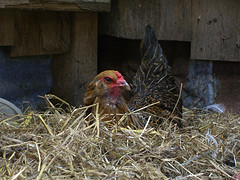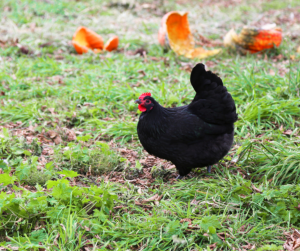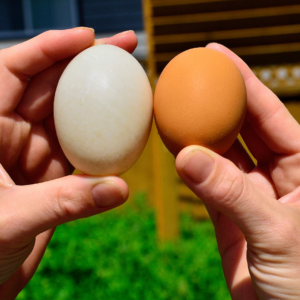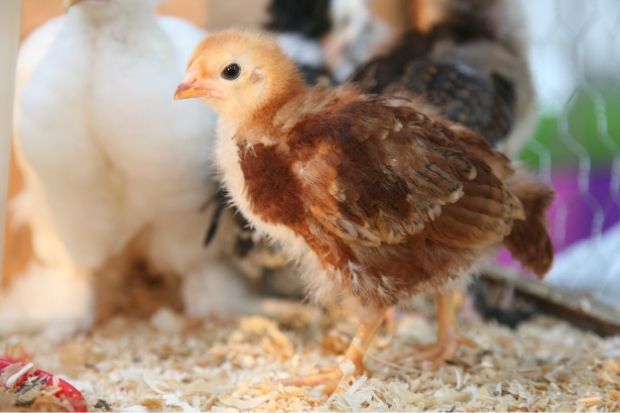 What Do Baby Chicks Eat? Baby chicks grow quickly, doubling their hatch weight in the first week and growing up to seven times their hatch weight in the first month. To support this early growth, baby chicks should eat a complete starter-grower feed which contains the 38 unique nutrients they need to start strong and stay strong. A starter-grower feed with the Chick Strong® System helps raise strong chicks that grow into happy, healthy hens.
What Do Baby Chicks Eat? Baby chicks grow quickly, doubling their hatch weight in the first week and growing up to seven times their hatch weight in the first month. To support this early growth, baby chicks should eat a complete starter-grower feed which contains the 38 unique nutrients they need to start strong and stay strong. A starter-grower feed with the Chick Strong® System helps raise strong chicks that grow into happy, healthy hens.
An apple a day keeps the doctor away. No dessert before dinner. Eat your vegetables! Do you remember hearing these phrases at the dining room table while growing up? Although you may have hated brussels sprouts, these wise words had the best intentions: Eat healthy, so you can grow strong.
We give advice with the same intent to backyard chicken raisers.
Lifetime success begins on day one. It all starts with chick nutrition and care. Baby chicks need 38 unique nutrients to grow into happy, healthy hens. Each of these nutrients – and the proper balance of them – plays a role in growth, performance and flock happiness.
Raising baby chicks into happy, healthy hens starts on day one:
Your mother’s advice to eat more vegetables wasn’t just something to roll your eyes at. A balanced diet supports life-long health and well-being.
Industry research shows the long-term impact of early nutrition on lifetime health and performance.1 The same holds true for backyard chickens. Feeding chicks for a strong start can better equip them for a lifetime of success.2
Just like people and other animals, chicks need a strong start to grow into happy, healthy adults. Many people begin raising backyard chickens for farm fresh eggs, but before the first egg arrives, early chick nutrition is the foundation.
Early nutrition develops the digestive tract and builds a healthy immune system, ultimately improving chick growth.3 Providing chicks a complete starter-grower feed is key.
Chicks grow quickly, doubling their hatch weight in the first week and growing up to seven times their hatch weight in the first month. This early growth requires the correct balance of nutrients.
What to feed baby chicks:
Start your chicks strong by feeding a complete starter-grower feed from day 1 until the first egg arrives around week 18.
- For chicks vaccinated for coccidiosis: Start & Grow®
- chicks not vaccinated for coccidiosis (or unsure of vaccination status): Start & Grow® Medicated
- organic chicks: Organic starter-grower
- ducklings: Purina® Duck Feed or Flock Raiser®
- mixed flocks: Purina® Flock Raiser®
- broiler chicks: Meat Bird
Each of these starter-grower feeds includes all 38 nutrients baby birds need to start strong and grow at the proper pace. Some nutrients directly impact bone, skeletal and chick growth while others work in tandem to support overall bird health and appearance.
Nutrients in Purina® complete starter-grower feeds include:
- 18% protein and 1.25% calcium for bone and body growth
- Prebiotics and probiotics for immune and digestive health
- Amino acids for muscle and feather development
- Marigold extract for brightly colored beaks, feet and legs and overall appearance
- Phosphorous and trace minerals for bone strength
- Vitamins A, D, E, K and B for overall health and growth
- Continue feeding the same starter-grower feed from day 1 to week 18. We recommend waiting to introduce treats or scratch to the diet until week 18. If you are feeding a complete starter-grower feed, your chicks do not need grit. If you start chicks on a medicated starter-grower feed, keep feeding that same medicated feed until their first egg.
Most layer chick breeds will lay their first egg around week 18. At that time, transition to a complete Purina® layer feed to help hens lay strong.
In conclusion, visit Kissimmee Valley Feed for all your backyard flock’s needs! Check out our supplies here.
Article Source: Patrick Biggs for Purina Mills






 Trick or Treat, Give Your Chickens Something Good to Eat! There is a cool breeze in the air and the leaves are starting to turn rich hues in many parts of the country. Yes, fall is upon us. It’s that wonderful time of year that brings us many bountiful tidings, including pumpkin spice-everything, hay rides and trick or treater’s. But what does the fall season mean for your chickens? The answer, is likely already a part of your seasonal tradition!
Trick or Treat, Give Your Chickens Something Good to Eat! There is a cool breeze in the air and the leaves are starting to turn rich hues in many parts of the country. Yes, fall is upon us. It’s that wonderful time of year that brings us many bountiful tidings, including pumpkin spice-everything, hay rides and trick or treater’s. But what does the fall season mean for your chickens? The answer, is likely already a part of your seasonal tradition! How Do Chickens Lay Eggs? Understanding Your Egg-Laying Chickens: Egg-laying chickens lay up to one egg per day at their peak. But how do chickens lay eggs? And how often do chickens lay eggs? The process takes 24 – 26 hours per egg. Eggs form from the inside out. They start with the egg yolk, egg white and egg shape.
How Do Chickens Lay Eggs? Understanding Your Egg-Laying Chickens: Egg-laying chickens lay up to one egg per day at their peak. But how do chickens lay eggs? And how often do chickens lay eggs? The process takes 24 – 26 hours per egg. Eggs form from the inside out. They start with the egg yolk, egg white and egg shape.